Langeoog – Birdphotography in winter
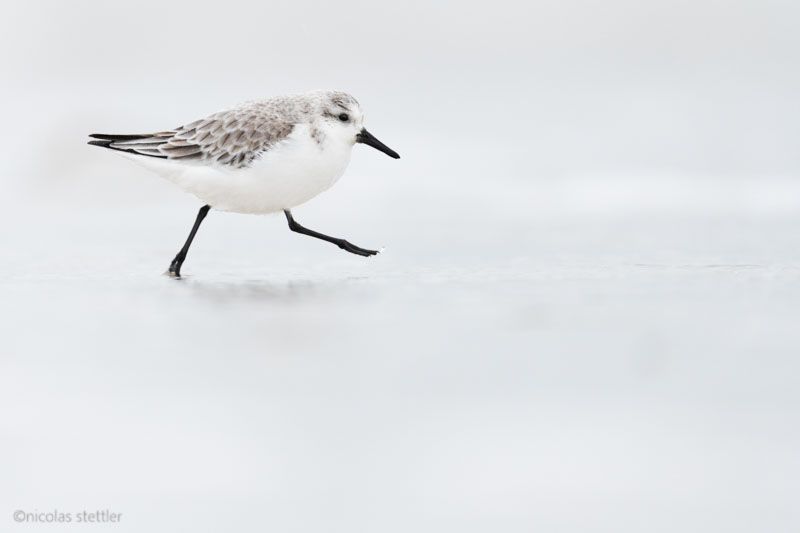
1/800 | f/ 6.3 | ISO 900 | 600mm
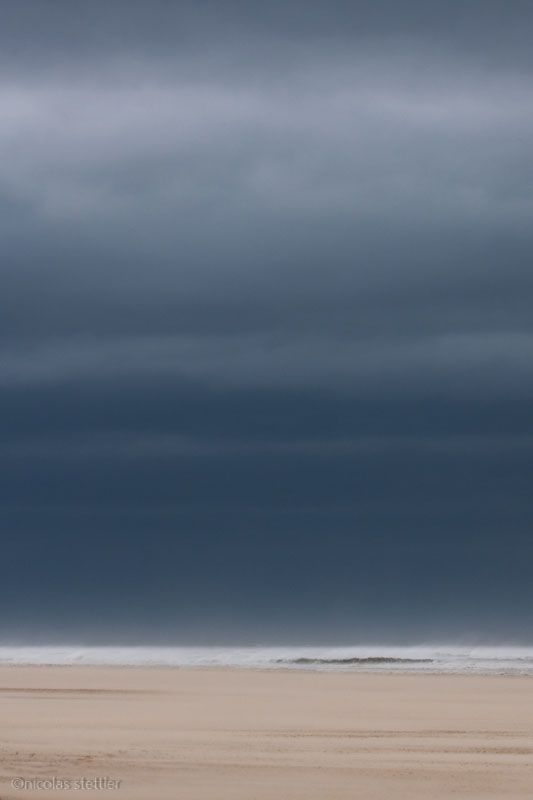
1/250 | f/ 14 | ISO 400 | 150mm
With public transport from Biel to Langeoog
By train the raw travel time from Biel was about 12 hours. Because of the connections I had to make a stopover with a night in Bremen. The whole journey took about one day.
Right before the storm ‘Sabine’ I arrived with the ferry on Langeoog. On the ferry I could already observe some eider ducks, a group of oystercatchers and a few curlews. Arriving on the island, the storm showed its first signs. The wind picked up and swept with more than 100 km/h over the beach. Large amounts of sand got picked up by the wind and flew through the air. Because I couldn't see any birds on the north beach, I tried some landscape photography. But because I had already mounted my telephoto lens and it was impossible to change the lens due to the amount of sand flying around, I was stuck with my telephoto lens. With my Sigma 150-600mm I could zoom out to 150mm. Nevertheless, the photographic possibilities were quite limited.
With this strong wind, taking pictures from the hand was impossible. But even with a tripod sharp, pictures were only possible with very short shutter speeds. Despite the difficult conditions I was able to take some photos before I left the beach completely soaked and sandy. I especially like this picture of the beach in front of a dark cloud. It is very minimalistic and yet it has a very strong atmosphere.
Unfortunately, the weather stayed the same during the next days. The wind swept over the island with full power and the rain alternated with graupel. Despite the rain the fine sand was whirled up and made photography difficult. The sand got into my eyes in no time. Because it is so fine, it wasn’t so easy to remove it and only when closing my eyes, I noticed how full of sand my eyes actually were. To protect the camera, I used a Raincoat from Lenscoat. The tripod was completely exposed to the sand and together with the heavy rain showers, the sand stuck to the tripod immediately.
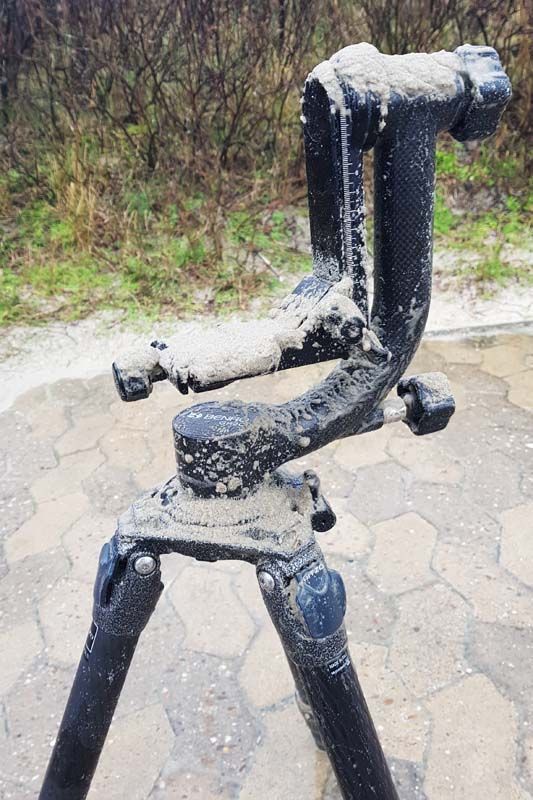
Birds on Langeoog in winter
Langeoog is one of the larger islands in the Wadden Sea. The Wadden Sea is habitat to an incredible number of shorebirds, sea ducks and seagulls. Especially in winter and during migration. At low tide, the shorebirds look for food on the large sandbanks in the Wadden Sea, while at high tide many birds show up on the numerous islands. Some birds also stay near the islands at low tide and can be observed on the steeper northern beaches.
On Langeoog and the other islands of Friesland, shorebirds such as Oystercatcher, Curlew, Sanderling, Dunlin, Redshank, etc. spend their winter. On the beaches and in the sand dunes you can also observe snow buntings, shorelarks (also known as horned larks) and, rarely Lapland buntings. Various gulls are to be seen on and around the islands. Species of gulls include the herring gull, the smaller gulls like black-headed- and common gull and the more contrasting lesser- and greater black-backed gull. Various species of geese can be discovered in the fields. However, the diversity of geese is much smaller than on the mainland and is mainly limited to grey-, barnacle- and brent goose. On the website ornitho.de many people upload their observations of birds. There you can see, which species you might be able to see on your trip.
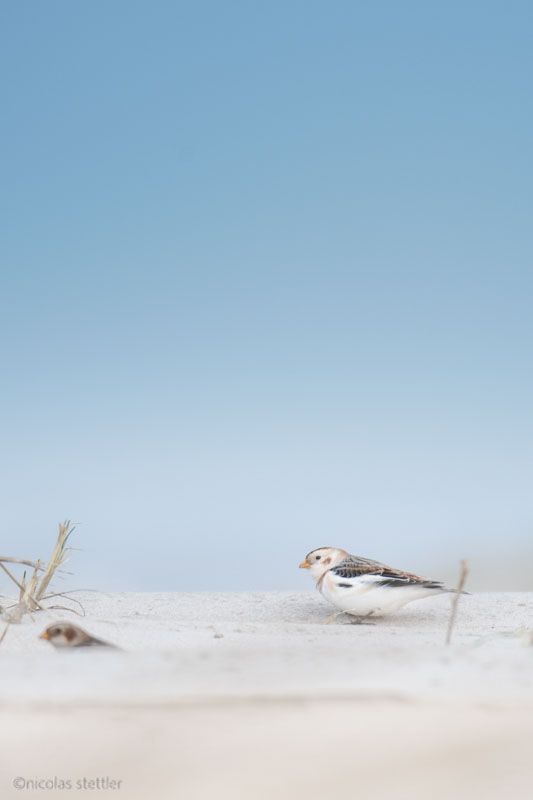
1/400 | f/ 7.1 | ISO 140 | 600mm
Snow Bunting on the beach
Because of the bad weather and the high storm tides, animals showed only sparsely. I could observe the Snow Bunting, one of my target species, from time to time but they mostly flew along the beach in larger groups and almost never landed in close proximity. When a group finally landed on the beach, they were quite shy and approaching was impossible. To add to that, there were surprisingly many people walking along the beach in spite of the storm. The snow buntings often got scared away and therefore, I only got a documentary picture.
Eider duck above the turbulent sea
Out in the sea I could observe a few common scoters and eider ducks flying along the beach fighting against the strong wind. The high waves together with the dark clouds in the background created a strong atmosphere. Fortunately, for a short moment the sun showed up, which gave the picture the necessary contrast and colour.
Because of the strong wind, tracking and focusing was a big challenge. After several passing eider duck troops and hundreds of blurry and shaky photos I finally had a sharp photo on my memory card.
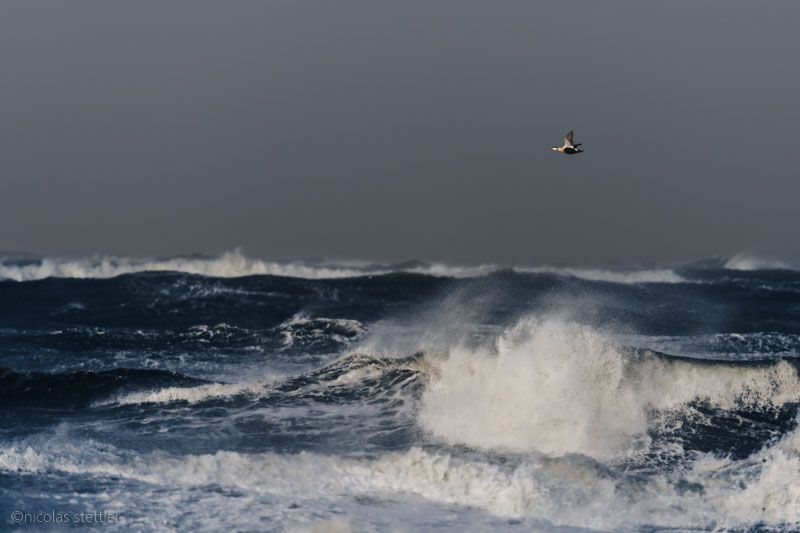
1/800 | f/ 6.3 | ISO 280 | 600mm
Flying barnacle geese
In the fields on Langeoog, thousands of barnacle geese rested alongside many greylag geese, lapwings and starlings. To photograph the barnacle geese from a close distance, I would have needed more time and a Hide. If the barnacle geese were disturbed, they flew up and searched for a new field. So I set up in a good distance and waited until the large flock flew up. This did not take too long. A passing-by rough-legged buzzard was enough and the thousands of geese rose into the air. Although the wind was still very strong that evening, at least the light was quite beautiful for once and I got quite an interesting image.
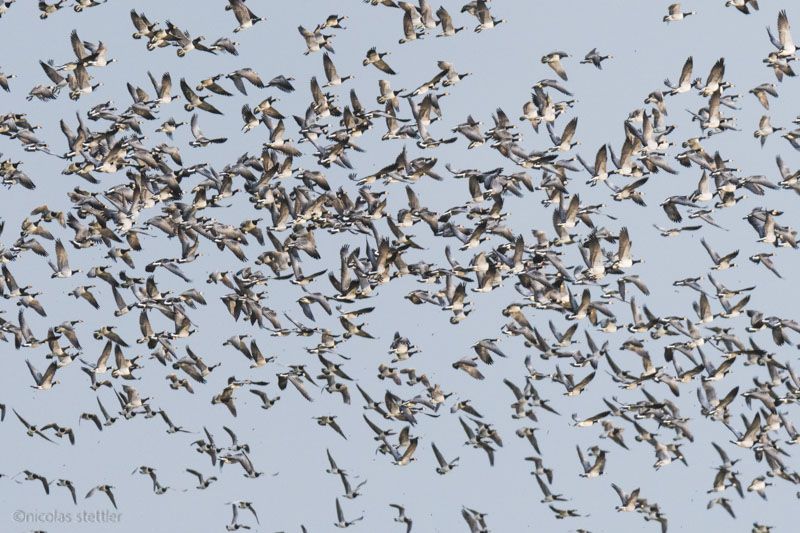
1/1250 | f/ 6.3 | ISO 640 | 600mm
Greylag goose in a field
Especially in the uninhabited, eastern part of the island, many greylag goose flocks were looking for food in the salt marshes. To get to the eastern end of the island I rented an e-bike from one of the dozens of bicycle rentals. This was of rather cheap quality. But against the strong wind it did its job. The good rain jacket and my rain trousers protected me quite well against the rain. But what I could not protect was my face and especially my eyes from the oncoming graupel. So, with pinched eyes therefore half blind, I cycled to the east end of the island. Unfortunately, I had overlooked a goshawk at the roadside. Suddenly it flew directly over my head and off into the distance. Some small troops of greylag geese of up to 8 individuals were also resting right next to the cycle path. But they were all quite shy. With a little caution and patience, I was able to get a little closer and I managed to get a few images.
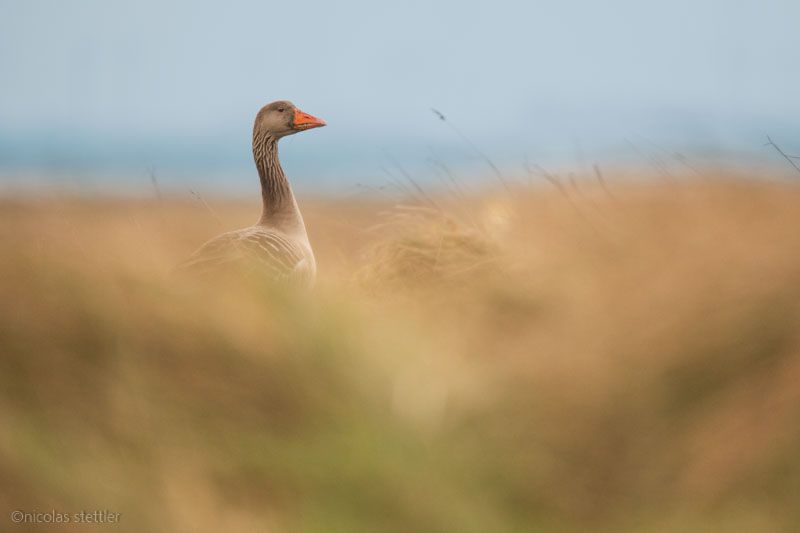
1/640 | f/ 6.3 | ISO 200 | 600mm
Sanderlings on the beach
Especially the sanderling was a big goal of my stay on Langeoog. But in the first days I had no luck with the species. Only once could I see three sanderlings flying past. Then, on the fourth day, I spotted four small white birds running along the waterline on the beach. Just from their behaviour I could tell that they must be sanderlings. A few meters up the beach I laid down on the ground at the shoreline. The sanderlings didn't care about me at all and they were running closer and closer to me. It was still very windy and even the Sanderlings had difficulties to move forward against the wind. After some time, the sanderlings were too close and the AF could not follow the fast birds. I put the camera aside and enjoyed the moment without having to look through the viewfinder. The sanderlings continued to run up the beach before they finally flew up and away.

1/800 | f/ 6.3 | ISO 1600 | 600mm
Until the last day this encounter remained the only one. On the last walk along the beach I discovered a larger group of sanderlings. At least 20 sanderlings were running along the beach. As before, I laid down on the ground in front of the Sanderlings at the waterline. Like the first time the sanderlings weren’t bothered by my presence. When the sanderlings were next to me at the shoreline, suddenly a big wave came up the beach. The little shorebirds ran away from the wave and suddenly stood right around me. But the wave didn’t stop yet and was still moving towards me. I quickly had to make a decision. Either I would probably scare away the sanderlings but I would stay dry or I would get a little wet, but I could photograph the sanderlings at close range. I decided on the second option. I was able to take pictures of the beautiful shorebirds looking for food before they finally ran further along the beach.
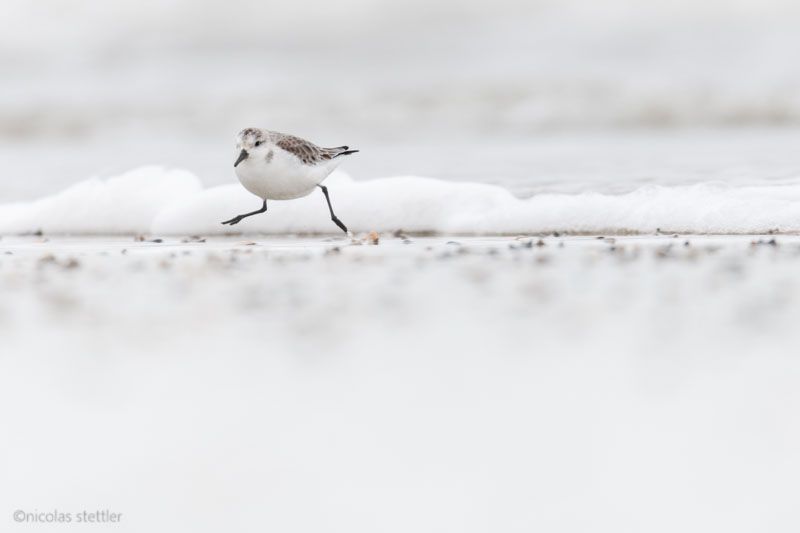
1/800 | f/ 6.3 | ISO 900 | 600mm
As I was not sure if I already had a good picture on the memory card, I decided to overtake them and try again. But they were surprisingly fast, and I had to run a good distance along the beach so that I had enough distance to lay down on the ground again. Again, I didn’t seem to bother them much. One of the sanderlings decided to run up the beach and so I was able to take a picture some colour in the background. Despite the Raincoat the camera was now a bit sandy and so I decided to go back to the accommodation to clean the camera. Unfortunately, the sunset was covered by the clouds again and so the photos of the sanderlings remained the last of this trip.
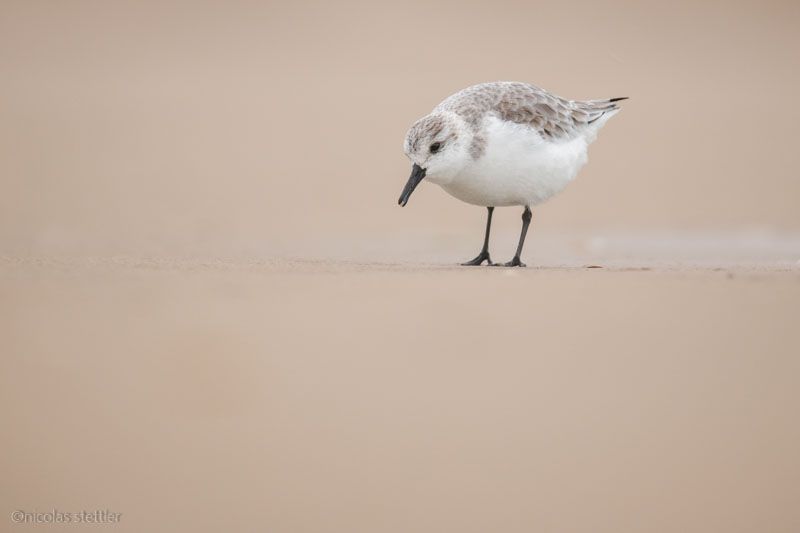
1/800 | f/ 6.3 | ISO 1250 | 600mm
Despite the very bad weather and only few sightings of wildlife, I got back on the ferry with some photos that I like. Photography on Langeoog was an endurance test for me as well as for all the equipment and I am now looking forward to some better weather again. But I am sure that this wasn’t the last time I was on Langeoog. But hopefully the weather will be a bit better next time.

